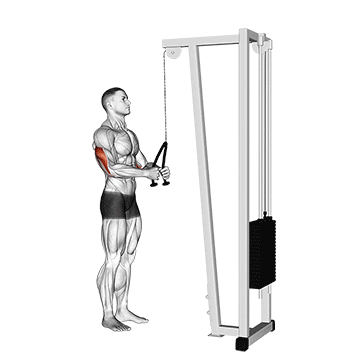The Cable Pushdown with Rope Attachment is a triceps isolation exercise that targets the muscles at the back of your upper arms. This exercise is commonly performed using a cable machine with a rope attachment.
How to perform
Here are the step-by-step instructions for performing Cable Pushdown with Rope Attachment:1. Begin by attaching a rope handle to the high pulley of a cable machine.
2. Stand facing the cable machine with your feet shoulder-width apart and knees slightly bent.
3. Grasp the ends of the rope with each hand, palms facing each other. Your hands should be positioned at chest height.
4. Keep your elbows close to your sides and engage your core muscles to stabilize your upper body.
5. Start by extending your arms downwards until they are fully straightened, and only your forearms are in motion. Exhale as you push the rope down.
6. Hold the contraction for a brief moment and squeeze your triceps at the bottom of the movement.
7. Slowly return to the starting position by bending your elbows and allowing the rope to rise back up until your arms are at a 90-degree angle.
8. Repeat for the desired number of repetitions.
Tips:
- Keep your elbows stationary and close to your sides throughout the movement to focus on targeting your triceps effectively.
- Maintain a controlled and smooth motion, avoiding swinging or using momentum to lift the weight.
- Adjust the weight on the cable machine to suit your fitness level and ensure that you can perform the exercise with proper form.
Incorporate Cable Pushdown with Rope Attachment into your arm workout routine to strengthen and tone your triceps.
Equipment required
Cable
Cable equipment consists of adjustable pulleys attached to weight stacks that allow for resistance training. This equipment is commonly used for strength training exercises that target various muscle groups in the body, such as chest, back, arms, and legs. Cable equipment provides a versatile and functional way to perform exercises that mimic real-life movements, improving muscle endurance, stability, and coordination.


